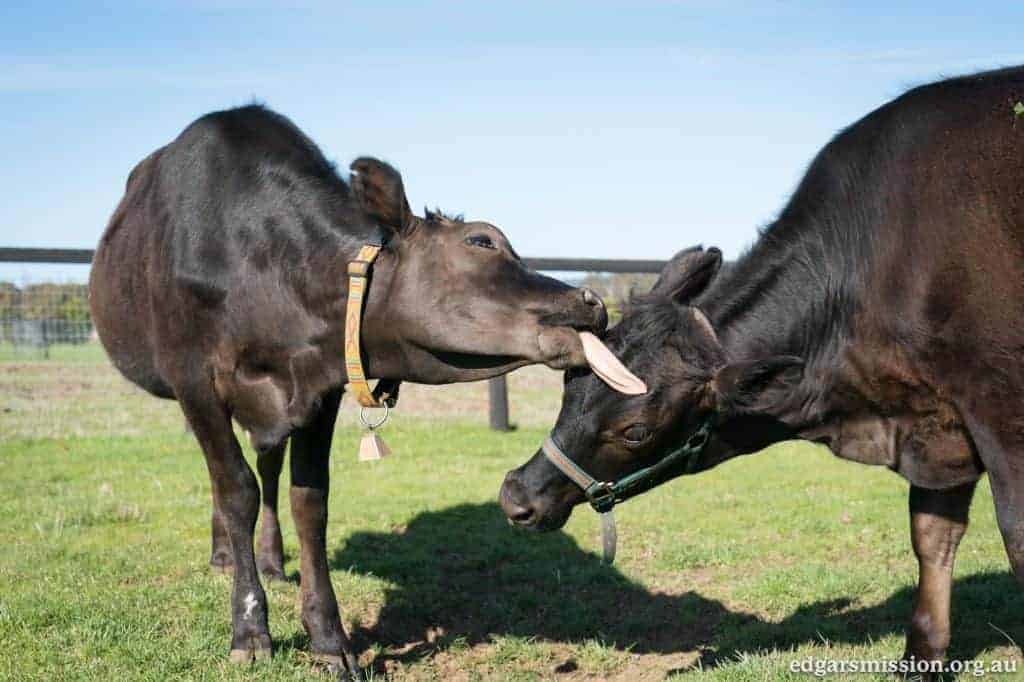
Updated April 14, 2021
Enrichment is often thought of as an “extra” or optional provision for residents. Sanctuary workers are understandably focused on providing the food, water, and housing that is necessary for residents to live. However, we are hoping that by incorporating enrichment as an aspect of general care, the lives of residents will be enriched. This is of particular importance for residents residing in smaller, more confined, or barren living spaces. In cases like these, enrichment can make a world of difference in the lives of residents. No one likes to be bored, including residents, regardless of species!
Developing An Enrichment Plan
It is important to understand the species-specific needs of your residents, in addition to considering their individual needs. An example of a species-specific understanding acknowledges that cowsWhile "cows" can be defined to refer exclusively to female cattle, at The Open Sanctuary Project we refer to domesticated cattle of all ages and sexes as "cows." are very motivated to graze and groom one another. However, many cows that have been rescued experienced interruption of their natural inclinations by early separation, overcrowding, and unnatural confinement in barren environments. These factors certainly affect how they develop, and some cows may have temporary or permanent health issues that affect their ability to utilize offered enrichment. For this reason, the individual also needs to be considered when developing an enrichment plan.
For example: On an individual level, consider Louie, the little spotted calf. Louie had surgery on his front leg, and as a result, he needs to be isolated and his movements must be limited- especially playing- for the next week or two. This means his best buddy, Frederick, can’t be in the same living spaceThe indoor or outdoor area where an animal resident lives, eats, and rests., as they can get a little rambunctious when together. Of course, this separation can have a desultory effect on Louie’s well-being. In this case, developing an enrichment plan should take into account Louie’s species-specific needs (social bonds) and his individual needs (specifically his bond with Frederick). Setting Louie up in a smaller living space and providing enrichment as a means of mental stimulation can assist in his healing. Examples of possible enrichment strategies for Louie include providing visual access to Frederick, placing a big picture of Frederick (with his face looking forward) in Louie’s temporary living space, or adding a mirror. That’s right! Studies have shown that heart rates and movements drop in isolated cows when they are provided with a mirror, and cows are able to easily recognize pictures of their friends! Another enrichment strategy may include adding a grooming brush to his living space, treated with lavender to encourage more frequent and longer use. Adding a special treat dispenser might be considered as well, but care should be taken to ensure that this dispenser isn’t a ball or toy that Louie is likely to trip on, or try to play with in a manner that could result in prolonged healing time or further injury.
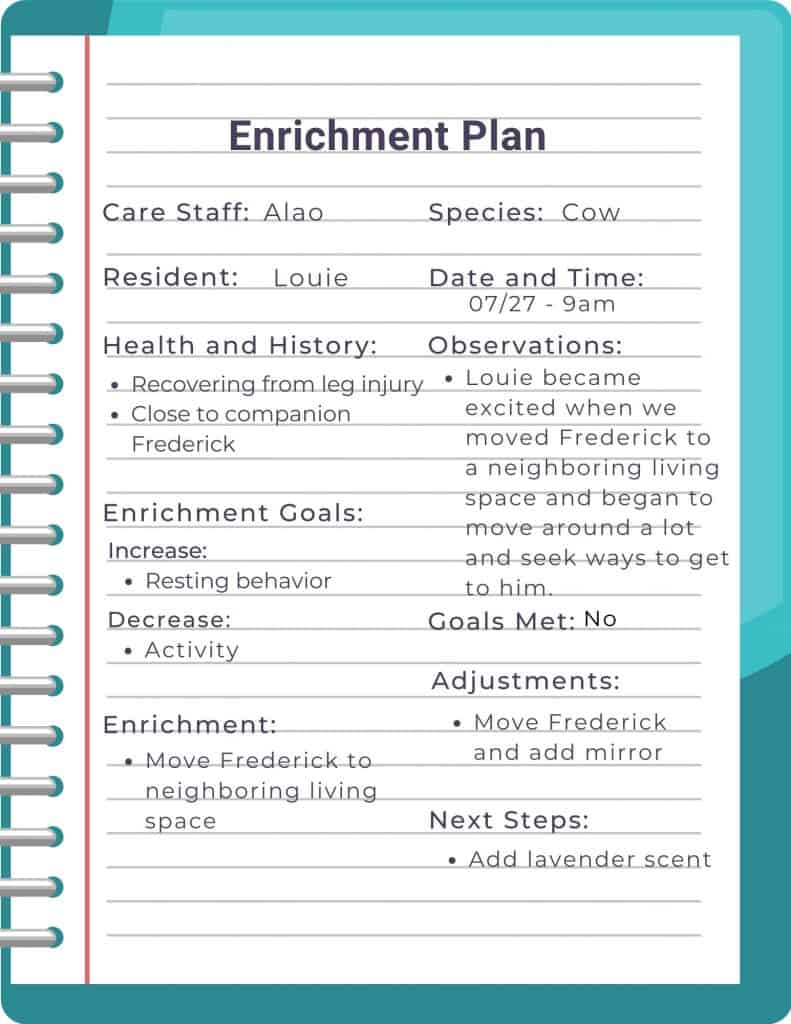
When developing an enrichment plan for residents, it’s important to consider the types of behavior in which you’re hoping to see an increase or decrease. For example, if you’re hoping to reduce confrontationalBehaviors such as chasing, cornering, biting, kicking, problematic mounting, or otherwise engaging in consistent behavior that may cause mental or physical discomfort or injury to another individual, or using these behaviors to block an individual's access to resources such as food, water, shade, shelter, or other residents. behaviors, there are particular enrichment options that are ideal for that, such as providing visual blocks within their living area. Do you wish to increase exploratory behavior? Novel objects and nutritional foraging enrichment may be better suited in this case. As a note: cows are more likely than other animals, such as goats, to experience neophobia, the fear of new objects and situations. Due to this trait, it is important to know your residents and introduce them to these new objects in a way that is not threatening, and allows them to choose whether or not they would like to interact. We know you have your hands full managing a sanctuary; developing an enrichment plan for species, particular groupings of residents, and individuals can actually help you save time and money in the future!
Now that we have covered what an individual enrichment plan looks like, we will cover some of the different types of enrichment for cows and how they could be implemented at your sanctuary.
Social Enrichment
This one may seem obvious, but it’s important to mention. Cows are social animals and it’s important for them to have access to other cows. Access to other cows in and of itself should generally be considered a need. Of course, there are times when this isn’t possible, due to medical issues, herd disagreements, or sadly, the death of their herd-mates. In cases like these where direct contact with others of their species isn’t possible, there are ways that you can enrich their lives during this time, as we mentioned above in the case of Louie and Frederick:
- Ideally, cows should be housed with other cows. If this isn’t possible, then extra steps should be taken to alleviate the stress caused by any sense of isolation.
- Provide visual contact with other cows.
- Add a mirror to their living space.
- Include a small amount of soiled bedding (if contagion isn’t an issue) from their original herd space.
- Add a large stuffed animal for calves.
- Cows have been known to form strong social bonds with humans as well as some other species, though this should be done thoughtfully and carefully to prevent injury and ensure the cow’s well-being.
- Add large pictures of their companions into their living space (particularly, front-facing pictures that highlight their faces).
- Add a grooming brush to encourage grooming behaviors in the absence of their grooming buddies. Adding a bit of lavender scent from time to time can encourage the frequency and duration of their use of the brush. Be sure not to overdo it or use it all the time, as this can reduce the effectiveness.
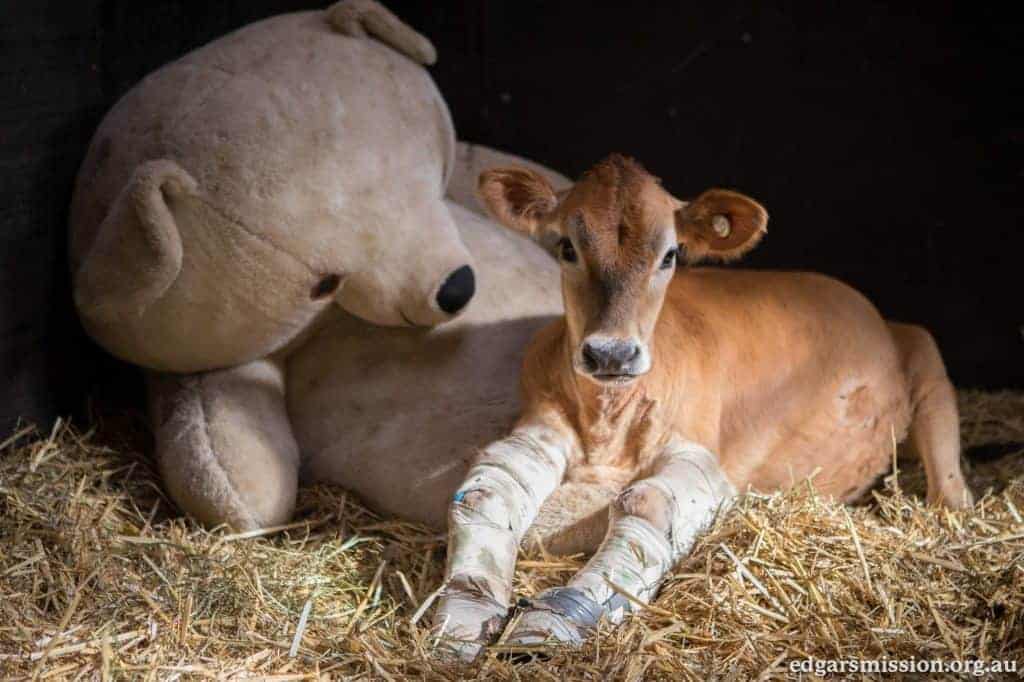
Photo: Edgar’s Mission Farm Sanctuary
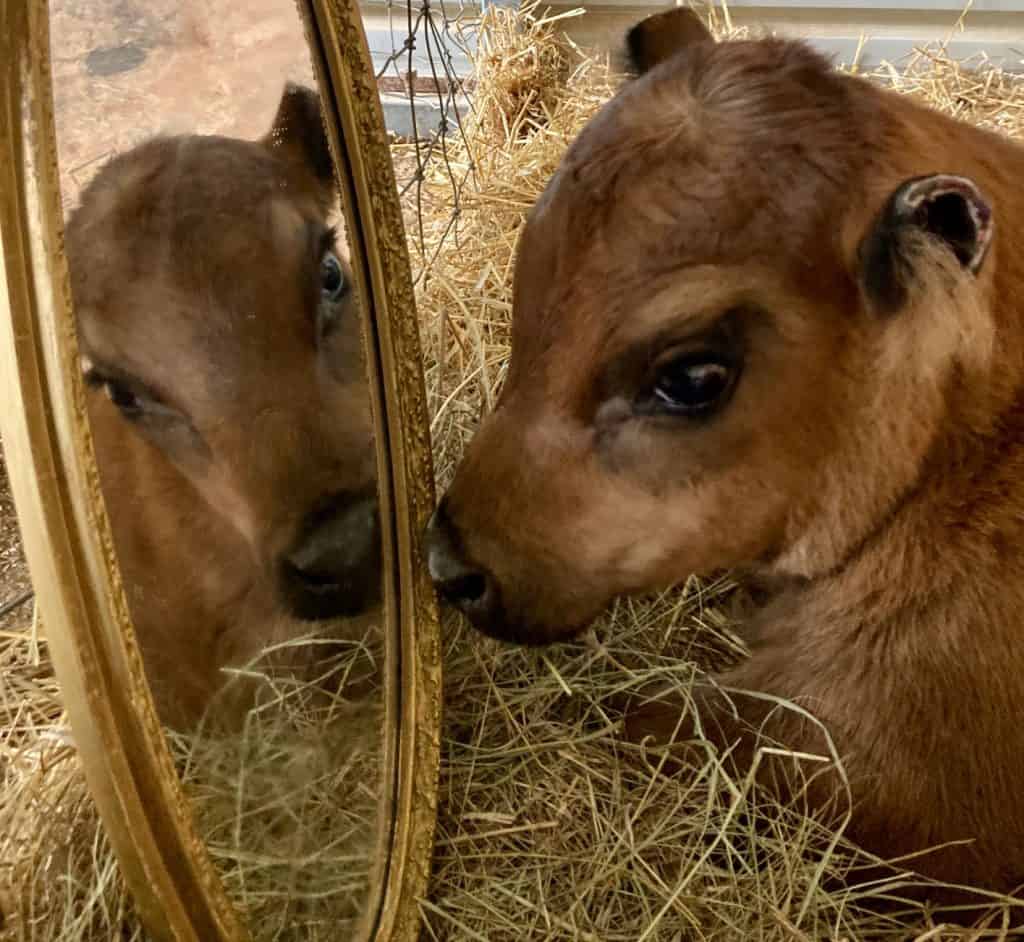
Photo: Amber Barnes
Physical Enrichment
Physical or structural enrichment refers to creating a dynamic living space for residents. This is where you should think about what your resident as a species and individual would want in a living space. Check out our Animal-Centered Design resource to learn more about this. Let’s look at some donkey-specific physical enrichment:
- Providing multiple water and food “stations”.
- Provide different piles of substrate like dirt or leaves or mulch (cow-safe).
- Set up self grooming stations.
- Set up a “trail” using moveable, temporary fencing in a way that encourages them to make use of their outdoor living space to get to certain high value grazing spots. This can also encourage them to run with their companions, so it’s important to ensure spacing is wide enough so no one feels trapped.
- If you have access to wooded areas (ensure everything is cow-safe), these can make wonderful parts of outdoor living spaces for cowWhile "cow" can be defined to refer exclusively to female cattle, at The Open Sanctuary Project we refer to domesticated cattle of all ages and sexes as "cows." residents .
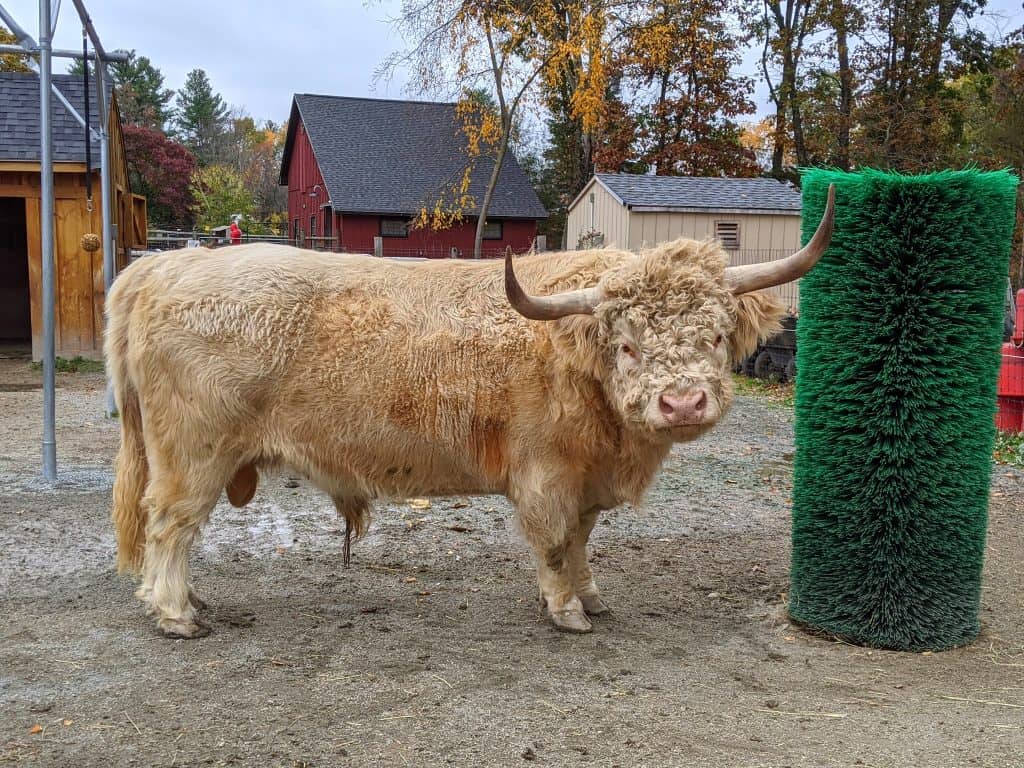
Photo: Unity Farm Sanctuary
Nutritional Enrichment
This is a fun one! We all know everyone loves a good meal, or better yet, a tasty treat! Here is a list of ideas for nutritional enrichment for your cow residents:
- Take a large water jug and drill a handful of holes on the side of the jug. This transforms the jug into a food dispenser when the cows roll and nudge it!
- Another option is to place treats that can be easily grasped with their tongues in large wiffle-type balls, and attach them to fencing with zip ties throughout the living space (but cut off the tail of the zip tie to prevent cow residents from eating them and be sure the ball couldn’t be swallowed in case they remove them!).
- Enrichment can even be less expensive than the above to make! Take a cardboard box, put holes in it, put treats inside, and place it in the living space!
- Or make paper mache pinatas full of yummy treats!
- You can use solid, rounded receptacles with holes punched through them as a do-it-yourself hay roller!
- During the fall, you can ask for donations of non-rotten pumpkins, which make a fun treat as well! Just make sure that potentially painted-on areas are removed prior to feeding them.
- A fun summer enrichment idea is to take a tub of water, chop up cow-friendly produce, and let them bob for treats!
- When temperatures are especially hot, add chopped up produce to a mold, add water and freeze, creating a cool treat that can keep your residents engaged on a hot day. While cows usually have their heads to the ground as grazers, you can experiment with placing a bit of rope into the mold as well and hanging it for them to investigate and nibble!
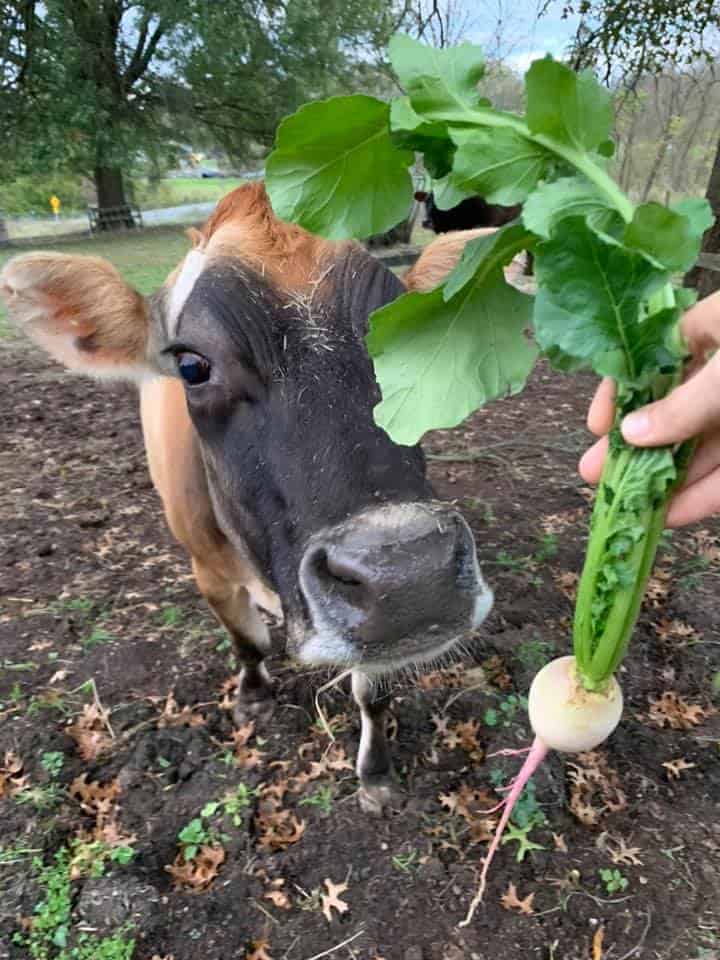
Photo: Lancaster Farm Sanctuary
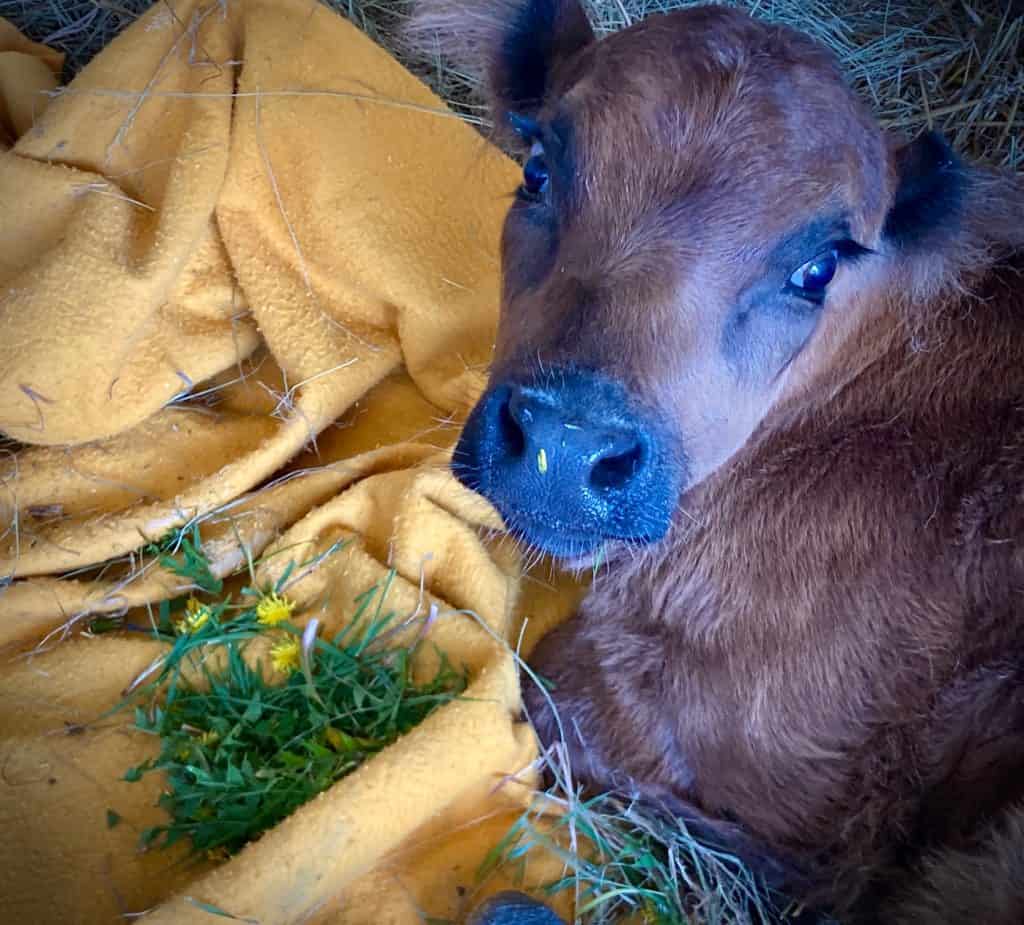
Photo: Amber Barnes
Sensory Enrichment
Sensory enrichment refers to enrichment that engages the senses. Arguably all enrichment engages the senses, but sensory enrichment focuses in on sight, touch, hearing, and smell. Each can provide interesting experiences for residents!
Visual Enrichment
Research has shown that cows can benefit from visual forms of enrichment, such as mirrors, in addition to pictures of their friends as mentioned above! We know that cows can distinguish the long wave-length colors yellow, orange and red (though they don’t distinguish red as well as humans) much better than the shorter wavelengths (blue, grey and green). This knowledge can help inform visual enrichment designs. Visual enrichment could include:
- Displaying computer screen savers, particularly those that move.
- Showing television programs or movies, especially for isolated cow residents.
- In other species, images of the same species has been projected onto walls and shown to promote behavioral imitation among the social group. Therefore, projecting scenes of happy cows may help your resident cows feel good too. Interest in images can fade after a few weeks, so they should be changed routinely to sustain interest.
- Provide mirrors. Note: Be mindful of individual personalities when adding mirrors. This may not be an ideal form of enrichment for them if they exhibit confrontational behaviors.
- Add colored buckets or balls (big enough that they aren’t a chocking hazard) and see which color they approach more often!
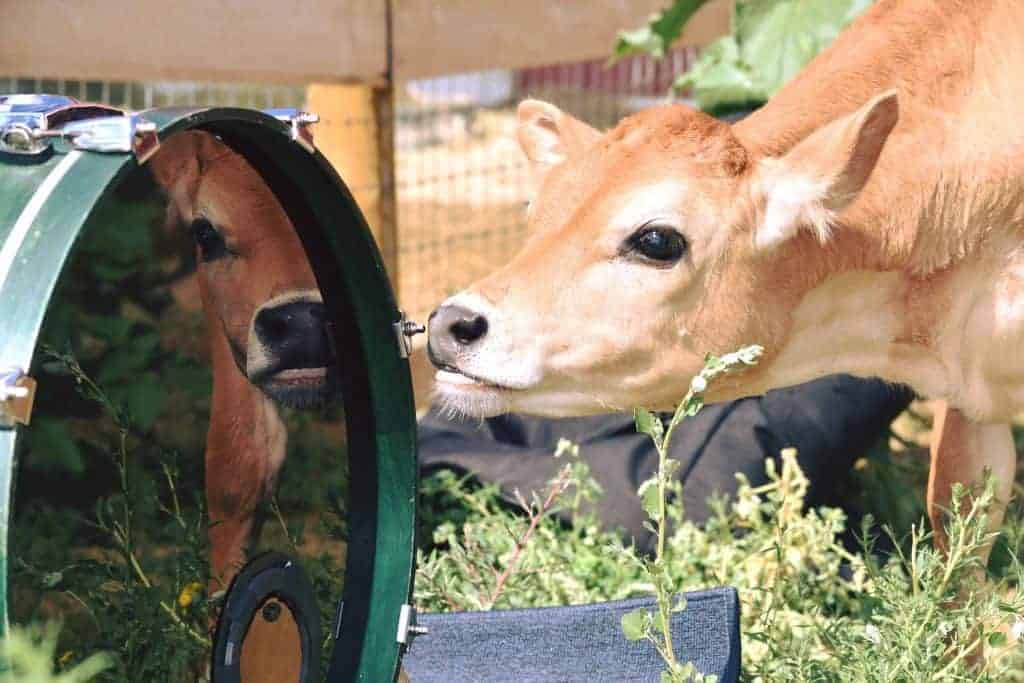
Photo: Luvin’ Arm Sanctuary
Olfactory Enrichment
Olfactory enrichment is often overlooked when considering cows. However, studies have shown that cows have an advanced sense of smell, and providing cows access to certain smells can contribute to feelings of safety (though these studies focus more on the familiarity of smell than the properties of a scent itself).
- If you need to transfer a cow to a new living space, add a bit of soiled bedding from their previous space for a familiar scent that may make the adjustment a bit easier.
- Cows have been shown to prefer smells like lavender, and while they prefer self grooming brushes over a simply putting lavender on a fence post, they do show interest in that scent and this can be used to encourage the use of brushes.
- Try other scents by adding them to a grooming brush. Leave one unscented and one with lavender, then add a different scent to another, and observe which they use the most!
- Rub aromatic herbs on fence posts or other living area surfaces!
- Add scents to other enrichment items to “spice” things up a bit!
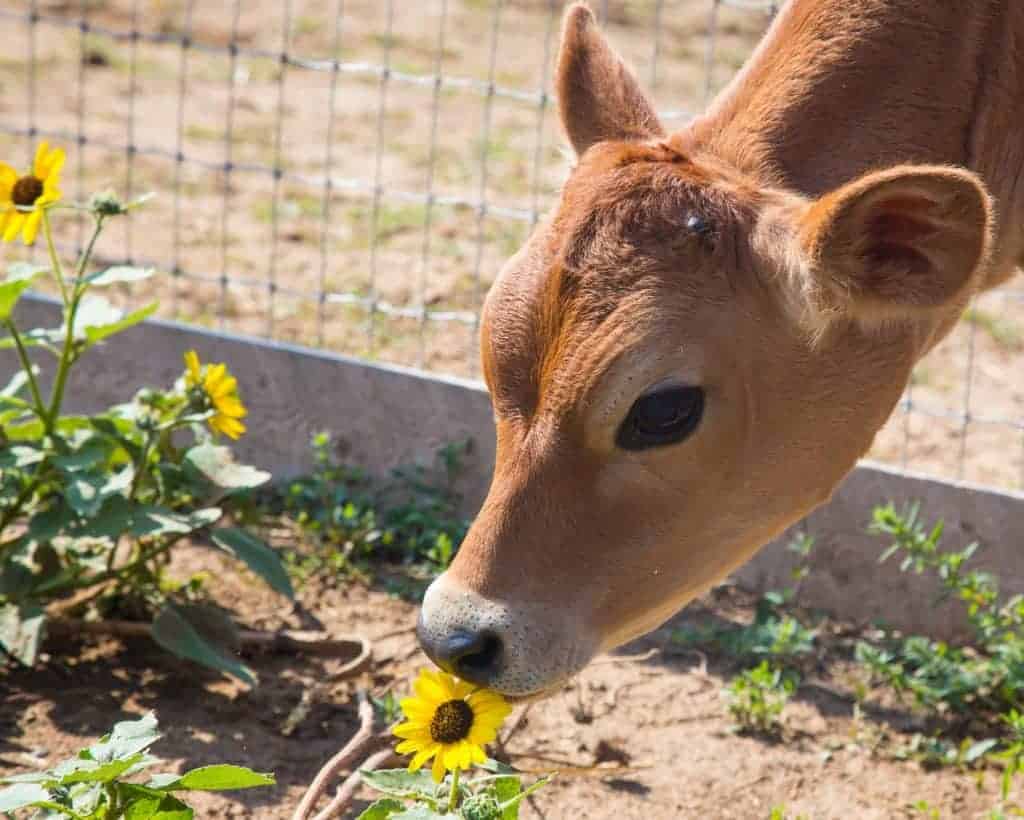
Photo: Luvin Arms Animal Sanctuary.
Auditory Enrichment
Do you love a good tune? Or have a favorite song that soothes you? The same can be true for cows!
Cows have nearly double the frequency range of humans, and auditory enrichment should be implemented with this in mind! Studies have shown that cows can become stressed in noisy environments. If you wish to try auditory enrichment, err on the side of caution and keep sounds low.
- Cows have been shown to experience reduced fear when classical music is played for them. However, this may be an indirect effect, as the human handlers may have become more relaxed upon hearing the music, and their calmness may have allowed the cows to feel calmer. Do a little experiment of your own and pick an hour to play calming, classical music, as you see how your cow residents respond!
- Cows verbally communicate quite well with one another. You could try playing happy, calm cow sounds for them. Be mindful of their reactions, as cows who are more fearful or exhibit more confrontational behaviors may become stressed out by the idea of other cows in their living space.
- Adding tactile enrichment that makes sounds while manipulated is another option. For example, you could hang a bell on a string that makes noise when residents touch it.
- Implementing wind chimes with lower octaves could be attempted as well. Remember: it is important to observe their responses to the enrichment and remove it if residents exhibit fear behaviors.
Tactile Enrichment
To encourage cows to interact with their environment and redirect otherwise problematic behaviors, consider adding tactile enrichment to their living spaces. Cows use their tongues a lot to explore things. They also use their hooves! Tactile enrichment might include:
- Hanging a rope or chain from the fence or wall of their living space (being careful that they can’t ingest them).
- Adding piles of sand or other types of substrate for exploration can be stimulating and offer residents a fun choice.
- Adding balls, boxes, or anything that doesn’t pose a danger but might be interesting to touch, taste, or manipulate. Just be sure they aren’t a choking hazard!
- Introducing one of those those great big rubber exercise-sized balls and letting them push it around. However, it is important to consider the needs of your individual residents. Objects like these may not be advisable for senior cows and others with certain mobility issues as they could result in serious injury.
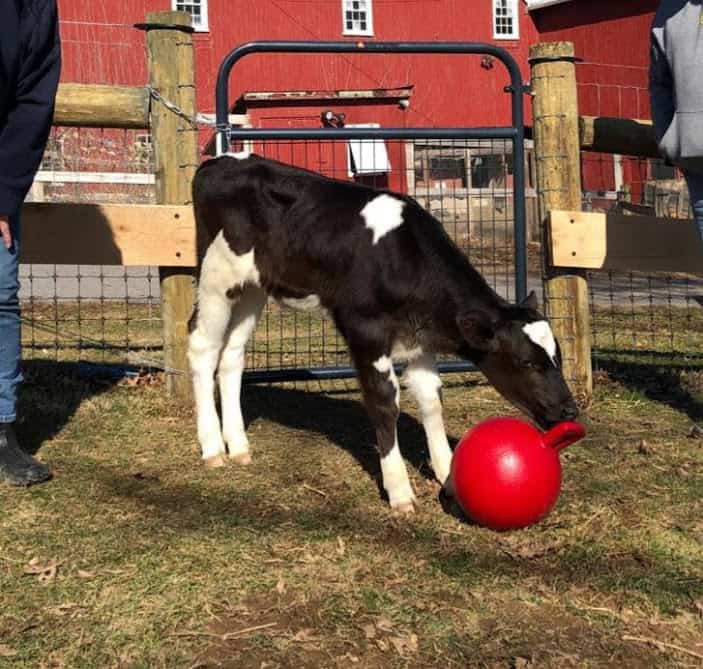
Photo: Lancaster Farm Sanctuary
Cognitive Enrichment
Cognitive enrichment involves experiences or environments that encourage curiosity, problem solving behaviors, and learning. A number of enrichment strategies listed above also fall into this category. Puzzle feeders and engaging with curious things in their environment are examples. But let’s touch on another form of cognitive enrichment: positive reinforcement learning (This is often referred to as “training”, but we like to refer to it as clicker “learning”, “play” or “bonding”).
- Positive Reinforcement Engagement
- Many cows may enjoy interacting with their human caregivers. One way to build a strong human-cow bond and boost cognitive functioning in your cow residents is to engage in clicker “learning”. Clicker learning and positive reinforcement are not interchangeable words. However, a clicker can be a useful tool during positive reinforcement engagement!
- Examples of activities to learn with your cow residents could include learning to choose a specific shape or color of an object, rewarding them with an immediate click and treat. Other examples include learning to push a large ball or plastic barrel around or to even play “soccer” with you (exercise and engagement), move through agility courses (you can often make a simple agility course with things you already have on hand or by getting inexpensive supplies), or even to ease fear or reactivity to medical procedures and loading into a trailer. This external link provides a brief tutorial on how to engage horses with a clicker. This works for cows too.
Focus On The Resident
It is important to note that clicker learning or play should only be implemented for the positive experiences that can be provided to your residents. This should not be used to encourage behavior that might be unsafe or exploitative.
Take Notes
Because every cow is an individual, they are likely to have individual responses to enrichment. When you first add enrichment items, be sure to carefully observe the reactions of your residents. To prevent discomfort to new items or enrichment schedules, consider adding novel objects to an area to the side of their living space, or in a space that doesn’t require them walking past the item to go inside, outside, or reach their water or food. If you believe one of your resident herds or individuals may be fearful of certain enrichment, encouraging them to investigate object while you are sitting and holding the object can help ease fears. Using food or treats to motivate them to interact with the item is a great way to start. (Remember to use caution when handing out treats to a group of residents. You can quickly put yourself in an unsafe situation! ) Giving your residents the option to engage or not with enrichment items can be empowering and improve emotional states. Be sure to make notes of any reactions and when their level of interest seems to subside. This will help you know how to best schedule days to change up their enrichment and provide them with a mentally stimulating environment.
Novelty
Novelty can be enriching on its own. Making changes to the “furniture” arrangement, the placement of food, or the addition of balls, and toys can all create an interesting and enriching environment for your cow residents. Cows are clever and become bored after some time with provided enrichment. For this reason, it is important to incorporate “switch it up” days into your residents’ enrichment schedules. As mentioned above, it’s important to take notes on group and individual responses so you can properly tailor enrichment to the interests and needs of your residents.
Remember, some cow residents may be uneasy or fearful of new items in their living areas. As such, it is vital to know your residents as individuals and ensure that you introduce new things in ways that give them plenty of space to avoid going near the items, and does not prevent them from accessing important resources such as water, food, or shelter. Additionally, ensure you provide enough enrichment to prevent dominant residents from preventing other residents from accessing the enrichment. This is another area where knowing your residents comes in handy. If you know there have been confrontational behaviors around coveted resources in the past, you need to ensure you are considering this when developing your enrichment plan!
Building A Schedule
Once you learn more about your residents’ interests, you can build an enrichment schedule to provide varying forms of enrichment as part of your caregiving routine. This will keep things interesting for the cows and help provide a stimulating and happy life for your residents.
Do you have an exciting enrichment strategy you use with your cows? Tell us all about it!
SOURCES:
Enrichment For Farm Animals – Cows | Petfinder
Intern’s Final Project | Animal Keeper Blog
Invited Review: Environmental Enrichment Of Dairy Cows And Calves In Indoor Housing | Journal Of Dairy Science (Non-Compassionate Source)
Cattle Behavior | Cow Talk (Non-Compassionate Source)
Cattle | Animal Behavior (Non-Compassionate Source)
If a source includes the (Non-Compassionate Source) tag, it means that we do not endorse that particular source’s views about animals, even if some of their insights are valuable from a care perspective. See a more detailed explanation here.








